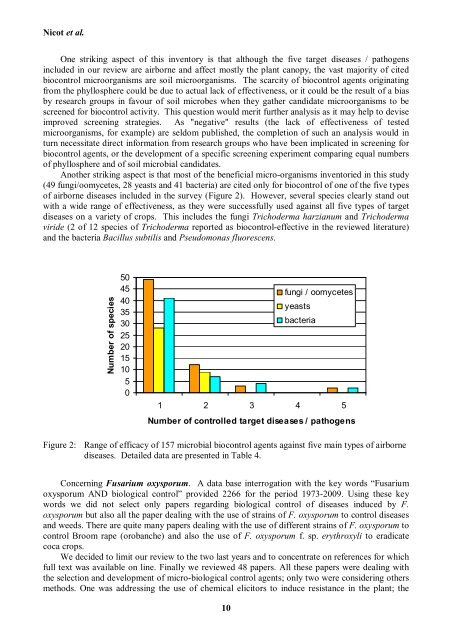Classical and augmentative biological control against ... - IOBC-WPRS
Classical and augmentative biological control against ... - IOBC-WPRS
Classical and augmentative biological control against ... - IOBC-WPRS
You also want an ePaper? Increase the reach of your titles
YUMPU automatically turns print PDFs into web optimized ePapers that Google loves.
Nicot et al.<br />
One striking aspect of this inventory is that although the five target diseases / pathogens<br />
included in our review are airborne <strong>and</strong> affect mostly the plant canopy, the vast majority of cited<br />
bio<strong>control</strong> microorganisms are soil microorganisms. The scarcity of bio<strong>control</strong> agents originating<br />
from the phyllosphere could be due to actual lack of effectiveness, or it could be the result of a bias<br />
by research groups in favour of soil microbes when they gather c<strong>and</strong>idate microorganisms to be<br />
screened for bio<strong>control</strong> activity. This question would merit further analysis as it may help to devise<br />
improved screening strategies. As "negative" results (the lack of effectiveness of tested<br />
microorganisms, for example) are seldom published, the completion of such an analysis would in<br />
turn necessitate direct information from research groups who have been implicated in screening for<br />
bio<strong>control</strong> agents, or the development of a specific screening experiment comparing equal numbers<br />
of phyllosphere <strong>and</strong> of soil microbial c<strong>and</strong>idates.<br />
Another striking aspect is that most of the beneficial micro-organisms inventoried in this study<br />
(49 fungi/oomycetes, 28 yeasts <strong>and</strong> 41 bacteria) are cited only for bio<strong>control</strong> of one of the five types<br />
of airborne diseases included in the survey (Figure 2). However, several species clearly st<strong>and</strong> out<br />
with a wide range of effectiveness, as they were successfully used <strong>against</strong> all five types of target<br />
diseases on a variety of crops. This includes the fungi Trichoderma harzianum <strong>and</strong> Trichoderma<br />
viride (2 of 12 species of Trichoderma reported as bio<strong>control</strong>-effective in the reviewed literature)<br />
<strong>and</strong> the bacteria Bacillus subtilis <strong>and</strong> Pseudomonas fluorescens.<br />
Number of species<br />
50<br />
45<br />
40<br />
35<br />
30<br />
25<br />
20<br />
15<br />
10<br />
5<br />
0<br />
fungi / oomycetes<br />
yeasts<br />
bacteria<br />
1 2 3 4 5<br />
Number of <strong>control</strong>led target diseases / pathogens<br />
Figure 2:<br />
Range of efficacy of 157 microbial bio<strong>control</strong> agents <strong>against</strong> five main types of airborne<br />
diseases. Detailed data are presented in Table 4.<br />
Concerning Fusarium oxysporum. A data base interrogation with the key words “Fusarium<br />
oxysporum AND <strong>biological</strong> <strong>control</strong>” provided 2266 for the period 1973-2009. Using these key<br />
words we did not select only papers regarding <strong>biological</strong> <strong>control</strong> of diseases induced by F.<br />
oxysporum but also all the paper dealing with the use of strains of F. oxysporum to <strong>control</strong> diseases<br />
<strong>and</strong> weeds. There are quite many papers dealing with the use of different strains of F. oxysporum to<br />
<strong>control</strong> Broom rape (orobanche) <strong>and</strong> also the use of F. oxysporum f. sp. erythroxyli to eradicate<br />
coca crops.<br />
We decided to limit our review to the two last years <strong>and</strong> to concentrate on references for which<br />
full text was available on line. Finally we reviewed 48 papers. All these papers were dealing with<br />
the selection <strong>and</strong> development of micro-<strong>biological</strong> <strong>control</strong> agents; only two were considering others<br />
methods. One was addressing the use of chemical elicitors to induce resistance in the plant; the<br />
10

















